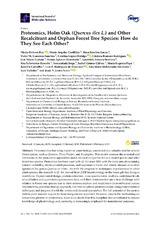Mostrar el registro sencillo del ítem
Proteomics, Holm Oak (Quercus ilex L.) and Other Recalcitrant and Orphan Forest Tree Species: How do They See Each Other?
| dc.contributor.author | Rey, María Dolores | |
| dc.contributor.author | Castillejo-Sánchez, María A. | |
| dc.contributor.author | Sánchez-Lucas, Rosa | |
| dc.contributor.author | Guerrero-Sánchez, Victor M. | |
| dc.contributor.author | López-Hidalgo, Cristina | |
| dc.contributor.author | Romero-Rodríguez, M. Cristina | |
| dc.contributor.author | Valero-Galván, José | |
| dc.contributor.author | Simova-Stoilova, Lyudmila P. | |
| dc.contributor.author | Echevarría-Zomeño, Sira | |
| dc.contributor.author | Jorge, Inmaculada | |
| dc.contributor.author | Gómez-Gálvez, Isabel | |
| dc.contributor.author | Papa, María Eugenia | |
| dc.contributor.author | Carvalho, Kamilla | |
| dc.contributor.author | Rodríguez de Francisco, Luis Enrique | |
| dc.contributor.author | Maldonado-Alconada, Ana M. | |
| dc.contributor.author | Valledor, Luis | |
| dc.contributor.author | Jorrín-Novo, Jesús V. | |
| dc.contributor.author | Sghaier-Hammami, Besma | |
| dc.date.accessioned | 2019-05-23T11:50:34Z | |
| dc.date.available | 2019-05-23T11:50:34Z | |
| dc.date.issued | 2019 | |
| dc.identifier.uri | http://hdl.handle.net/10396/18621 | |
| dc.description.abstract | Proteomics has had a big impact on plant biology, considered as a valuable tool for several forest species, such as Quercus, Pines, Poplars, and Eucalyptus. This review assesses the potential and limitations of the proteomics approaches and is focused on Quercus ilex as a model species and other forest tree species. Proteomics has been used with Q. ilex since 2003 with the main aim of examining natural variability, developmental processes, and responses to biotic and abiotic stresses as in other species of the genus Quercus or Pinus. As with the progress in techniques in proteomics in other plant species, the research in Q. ilex moved from 2-DE based strategy to the latest gel-free shotgun workflows. Experimental design, protein extraction, mass spectrometric analysis, confidence levels of qualitative and quantitative proteomics data, and their interpretation are a true challenge with relation to forest tree species due to their extreme orphan and recalcitrant (non-orthodox) nature. Implementing a systems biology approach, it is time to validate proteomics data using complementary techniques and integrate it with the -omics and classical approaches. The full potential of the protein field in plant research is quite far from being entirely exploited. However, despite the methodological limitations present in proteomics, there is no doubt that this discipline has contributed to deeper knowledge of plant biology and, currently, is increasingly employed for translational purposes. | es_ES |
| dc.format.mimetype | application/pdf | es_ES |
| dc.language.iso | eng | es_ES |
| dc.publisher | MDPI | es_ES |
| dc.rights | https://creativecommons.org/licenses/by/4.0/ | es_ES |
| dc.source | International Journal of Molecular Sciences 20(3), 692 (2019) | es_ES |
| dc.subject | Holm oak | es_ES |
| dc.subject | Quercus ilex | es_ES |
| dc.subject | 2-DE proteomics | es_ES |
| dc.subject | Shotgun proteomics | es_ES |
| dc.subject | Non-orthodox seed | es_ES |
| dc.subject | Population variability | es_ES |
| dc.subject | Stresses responses | es_ES |
| dc.title | Proteomics, Holm Oak (Quercus ilex L.) and Other Recalcitrant and Orphan Forest Tree Species: How do They See Each Other? | es_ES |
| dc.type | info:eu-repo/semantics/article | es_ES |
| dc.relation.publisherversion | http://dx.doi.org/10.3390/ijms20030692 | es_ES |
| dc.relation.projectID | Gobierno de España. AGL2009-12243-C02-02 | es_ES |
| dc.relation.projectID | Gobierno de España. BIO2015-64737-R | es_ES |
| dc.rights.accessRights | info:eu-repo/semantics/openAccess | es_ES |

